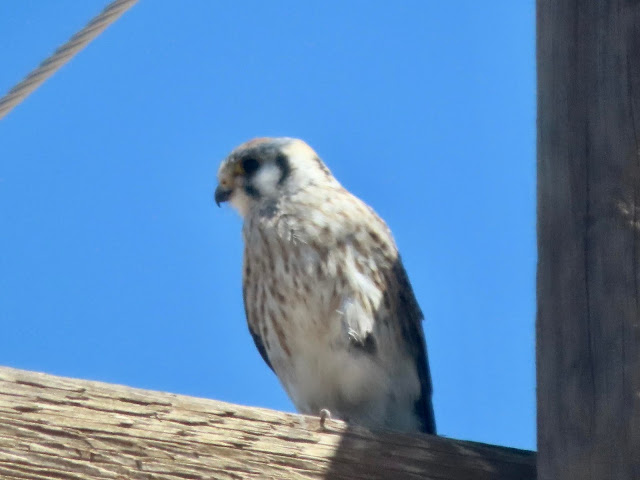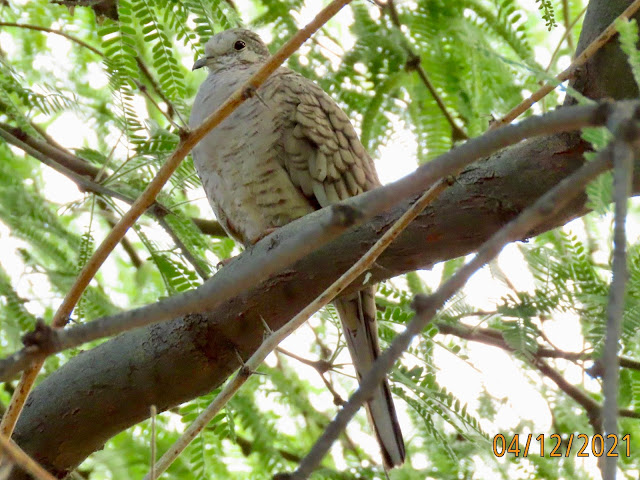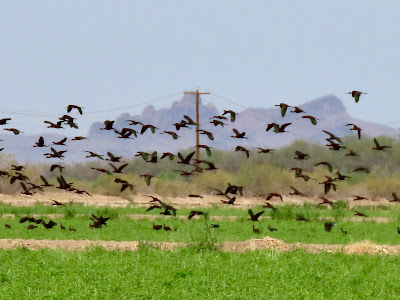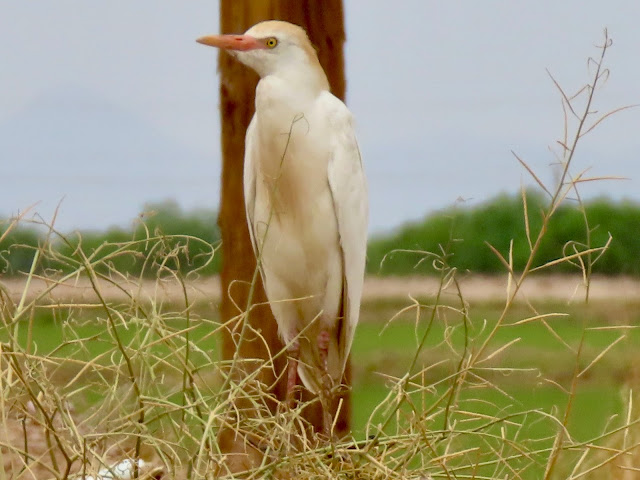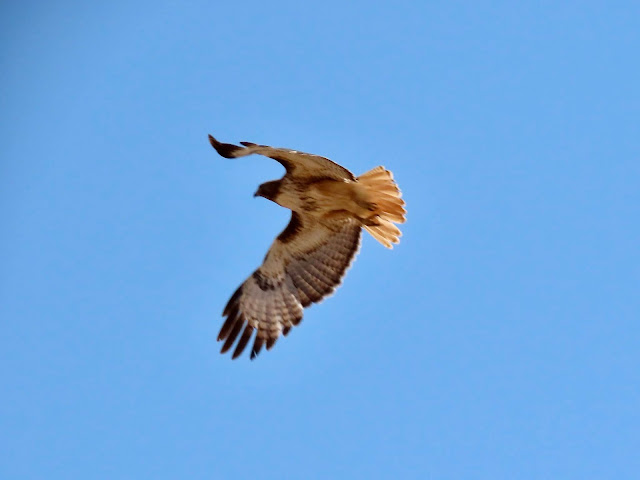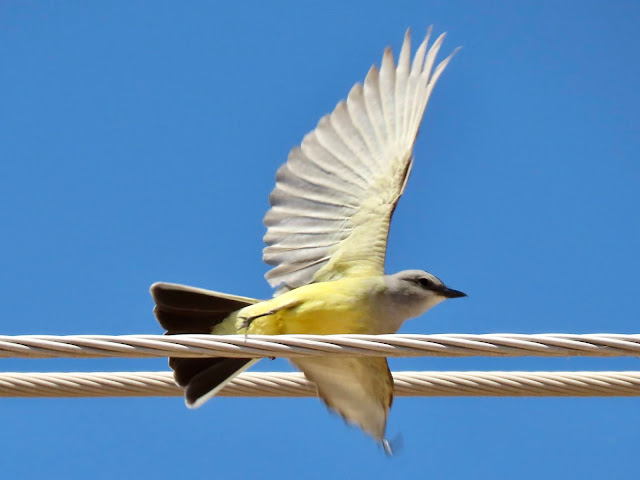In the past nine days, I’ve managed to bird in four distinct places with various birder friends.
1) Monday, April 12, 2021
Two women from Colorado that I met last year are visiting again for a short time, so we were able to bird The Riparian Preserve at Gilbert Water Ranch this morning - the first visit for them.
Although they were very interested in seeing the rare STREAK-BACKED ORIOLE, while birding our way to that location another birder told us he had been covering its known area since 6 a.m. looking for it with no luck. (This was 1.5 hrs later.)
Eventually, we reached that destination but both Judy and Karen are good birders who were intent on identifying anything moving in the trees, running on the ground, floating on the ponds, stalking the edges, and flying overhead as we walked toward our destination.
Difficult to catch an ANNA’S HUMMINGBIRD gorget when the sun hits it, I lucked out this morning.
On the 1/7 Trail, I asked if they heard the INCA DOVE calling. They acknowledged so I started looking really close by. It was almost directly over our heads, although its call can make it seem like it's much more distant.
Having forewarned Karen and Judy that many waterfowl had already headed north, it seemed like many species were still present in smaller numbers, including the photo below of CINNAMON TEAL, which at a count of 28 is no small number. Perhaps migrants are stopping by.
Two Drake and three Hen CINNAMON TEAL
Small flocks of BLACK-NECKED STILT foraged on several of the ponds we visited. See the photo below.
One of nine SNOWY EGRET we spotted
Having identified several VERDIN by their spring song, I noticed Karen trying to tease one out from interior limbs for a better view. She succeeded! Rare for me to get a good photo of that bird!
In past blogs, I've posted pictures of BLACK-CROWNED NIGHT HERON perched on low branches of shrubs staring fervently into the water for food. Today, it was incredibly camouflaged within a tree, busily preening.
BLACK-CROWNED NIGHT HERON, pausing to look at us while preening.
BLACK-CROWNED NIGHT HERON - preening in a mesquite tree
Having not visited the Water Ranch for some weeks, I was as excited as my visitors were about the number of bird species we found and identified plus the many more that were present. We did not catch the Mexican STREAK-BACKED ORIOLE, but Judy and Karen now know where to look for it on their own.
A great way to start the day!
As always, if you want to check our eBird list with photos, the link is below:
2) Sunday, April 11, 2021
When I discovered that a good birder visiting our community had never seen a CRESTED CARACARA, that indicated to me that another trip to Santa Cruz Flats was necessary. She picked me up at 6 a.m. for the hour's drive to North Picacho Highway, our entrance road to the Flats today. It was just a week ago, I had counted four (4) on the more eastern side of the Flats, so I hoped that Ann Rhodes would have a chance to see the big falcon.
Surprise! We had begun driving slowly on the highway since traffic was nil, when Ann asked what big bird was flapping its wings so fast as it flew north directly toward us.
"Pull over! I think that's your bird!
We both exited the car, binoculars on the bird and YES! - it was, indeed, a CRESTED CARACARA in a hurry. It flew right over us on its way northwest without stopping but did make one small circle over the field in front of us. Too early to have my wits about me, I didn't get a photograph. But we both saw the white ID markers well of the bird in flight.
Pic taken by me a week previously on 4/3/21 at a location farther east in Santa Cruz Flats
Well! You've seen your Life Bird! Are you wanting to go home now?
No, She laughed and I said that perhaps we would find more at last week's field. (Never happens that way and it didn't today either.)
Over the next five (5) hours, we stopped for many birds, including another Life Bird for Ann.
The MERLIN that had been hanging around Green Reservoir and Fast Track flew into a field on the north side of Green Reservoir as we headed east. We stopped; she grilled me on how it differed from the American Kestrel. It hovered like a kestrel, but that was the last of the similarities I saw.
"Although it's only a bit bigger than the kestrel, it looks different to me in flight." I was wracking my brain trying to think what else I could suggest when Merlin's pale-striped belly was caught in the sunlight making it appear white. It was the Prairie subspecies with pale stripes below. Its wings, too, are diagnostic: broader and more pointed than a kestrel. It also lacks the strong facial marking of the kestrel and its reddish-brown back.
After following Merlin's continued flight over and around the field, Ann finally said she had solved the riddle of how to tell it from the American Kestrel.
MERLIN - photographed along Green Reservoir Road in the Flats in January of this year.
We did see a few AMERICAN KESTREL perched on overhead utility wires and poles as we drove many of the dirt roads. See photo below:
We saw the usual WESTERN and CASSIN'S KINGBIRDs, LOGGERHEAD SHRIKE, RED-TAILED AND SWAINSON'S HAWK.
In addition to Ann's getting TWO Life Birds, the place held a few other surprises. With their heads down in the vegetation, it still wasn't difficult to identify the large flock (220) of WHITE-FACED IBIS when we came upon them. The breeding plumage white feathers around the base of its bill were not visible from our distance or were not yet present, but this is our primary species of Ibis.
A BARN SWALLOW is always fun to see. Several farms are located in the Flats, so it wasn't out of the ordinary to see a couple.
Driving east from where we had ended up, I couldn't believe my eyes! STOP!Ann saw them at the same time and hadn't been driving fast.
Fortunately, the CATTLE EGRET was not skittish when I emerged from the car for just a few photos. It had been a very long time since I had seen any in breeding plumage, so was elated with the final surprise of the day!
View this checklist online at https://ebird.org/checklist/S85334689
3) Monday, April 5, 2021
Knowing that the Salt River is one of my favorite birding spots, Hinde Silver suggested we check out the birds that might be arriving there. Beginning at 6 a.m., we birded for 2.5 hours. It's amazing how different the temperature there can be when the cold water is running high in the river as it was today. Not dressed for 64°F, I was chilled for a good half hour before working up enough energy to get comfortable. Birding at our usual slow pace through Coon Bluff Recreation Area, we saw:
Birds of Note: 1) A ROSEATE SPOONBILL flew downriver (west) before changing its bearing to northwest. Quite a sight of this unmistakable bird! Its feathering was deeply pink. Having had a ROSP at Gilbert Water Ranch for many months, I can't say this was the same bird just out and about, but its presence was not as shocking to see under this circumstance. Unable to get a photo, I might have been hard-pressed to allow for having seen one had it not been for the one at GWR for so long.
2) SPOTTED SANDPIPER is not an unusual sighting at this location, but one with its spring plumage of "spots" instead of its winter feathering made it special today.
3) ASH-THROATED FLYCATCHER was a welcome migrant that may well spend the summer. A brownish bird, it's a bit smaller than a Robin with pale underparts and rufous tail. The tail is outlined with darker brown feathers that come together at the tip of the tail. Its call, "ka-brick" or "ha-weer" was a welcome sound! It managed to elude the camera quite well. The one below is the best I managed today.Walking beyond the developed and fenced recreation area, blooming ground cover in the desert sand made me smile. Many such verbena-like plants covered the landscape in certain areas.
LUCY'S WARBLER birds were more prevalent in the mesquite bosque beyond the picnic area; their voices accompanying us the entire distance.
These two feral horses below were part of a band that we saw several times. At first, they seemed wary of us, but we just stood still, talking to them softly. Photographers were pursuing another band who galloped off in a cloud of dust. Later, the band we had seen came running toward the river, but with it so high, they really didn't seem to want to cross. They returned to the desert area and milled around our area before walking off. We came upon them one more time and they were calm around us, so I took a photo.
4) Easter Sunday Morning, April 4, 2021
In two hours of gentle walking, Ann Rhodes and I spent Easter morning with 40 species (and many individual birds) at Granite Reef Recreation Area along the Salt River. BUFFLEHEAD, REDHEAD, RING-NECKED DUCK, and other species caught our attention immediately.
GREAT BLUE HERON and GREAT EGRET were the only long-legged waders we spotted, but the mesquite bosque behind us was so full of bird songs, we turned our attention there. With trees leafing out, photos were not even an option for fast-moving birds like RUBY-CROWNED KINGLET and LUCY'S WARBLER.
Reaching the area of the dam, one wader was standing high on a cliff!
GREAT BLUE HERON
As we returned to the parking area by way of the berm next to the water catchment area, Ann spotted a female LADDER-BACKED WOODPECKER high on a bare snag. It was soon joined by a male that kept working its way up closer to the female - where I was able to get them both in one photograph, shown below.
Just getting out in the natural world is reward enough for me. When so much bird activity is added, it's just something I cherish.
To view our eBird checklist, click on this link: https://ebird.org/checklist/S84757612
Subsequent bird outings in April are incorporated in this blog, above.

